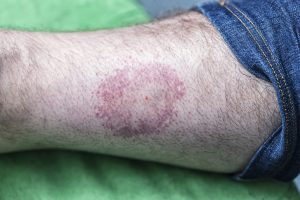 People can live for weeks, months, or potentially years without realizing that medical problems they’re experiencing are symptoms of untreated Lyme disease. This condition can produce a wide range of symptoms that are often associated with other diseases; as a result, it may not always be easy to identify their most likely cause.
People can live for weeks, months, or potentially years without realizing that medical problems they’re experiencing are symptoms of untreated Lyme disease. This condition can produce a wide range of symptoms that are often associated with other diseases; as a result, it may not always be easy to identify their most likely cause.
Lyme disease is most often transmitted through tick bites. Early signs and symptoms can begin up to a month after being bitten, but can also start to occur in as little as three days. These may include:
- Fever
- Headache
- Muscle and joint pain
- Chills
- Fatigue
- Rash or swollen lymph nodes at the site of the tick bite
More serious symptoms of Lyme disease may begin to occur days or months after the first signs appear. Some of these more advanced signs include:
- Severe headache
- Neck stiffness
- Rashes that have spread to other parts of the body
- Drooping in the face
- Arthritis and pain in the muscles, bones, joints, and tendons
- Heart arrhythmia
- Episodes of dizziness and shortness of breath
- Nerve pain or shooting pains/numbness and tingling in the hands or feet
- Brain or spinal cord inflammation
The erythema migrans (EM) rash that occurs in the early stage of Lyme disease can appear in a few ways for different people. The “classic” Lyme disease rash looks similar to a target, with a red ring that surrounds a central red spot. It can also appear as:
- An expanding rash that may have a central spot of crusted skin
- Multiple rashes in the same area with dark or discolored centers
- A red, oval-shaped plaque
- A ring-like rash
- A blue-hued rash
- An expanding red-blue rash with a clear spot of skin in the center
If you are experiencing potential symptoms of Lyme disease, please schedule an appointment at Flushing Hospital Medical Center’s Ambulatory Care Center by calling (718) 670-5486. If you are experiencing a medical emergency, please dial 911 immediately.
All content of this newsletter is intended for general information purposes only and is not intended or implied to be a substitute for professional medical advice, diagnosis or treatment. Please consult a medical professional before adopting any of the suggestions on this page. You must never disregard professional medical advice or delay seeking medical treatment based upon any content of this newsletter. PROMPTLY CONSULT YOUR PHYSICIAN OR CALL 911 IF YOU BELIEVE YOU HAVE A MEDICAL EMERGENCY.
